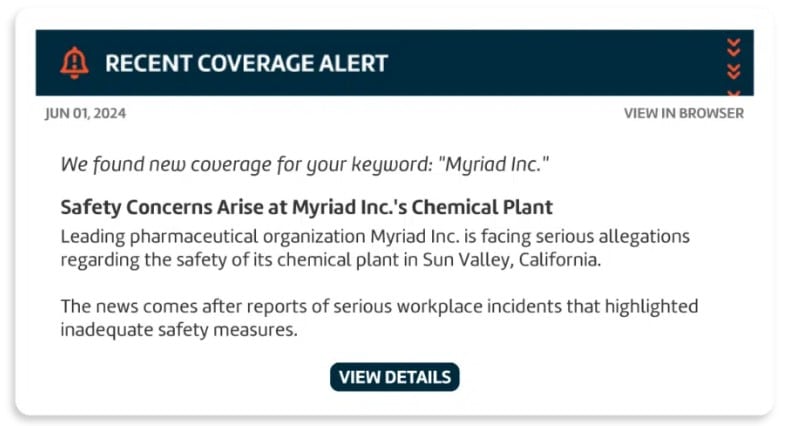A single tweet. A leaked email. A glitchy checkout screen.
That’s all it takes to turn a normal day into full-blown PR crisis mode.
Modern public relations is ripe for disruption—and the pressure’s mounting. And with real-time news cycles and high-stakes social media backlash, there’s no room for slow or sloppy responses.
You need to be clear and flexible, so you can respond appropriately without panic.
Let’s break down the key tactics to stay ahead of PR crises, so your messaging flexes under pressure instead of falling apart.
Why PR Pros Are Spending More Time on Crisis Response
Once upon a time, a PR crisis meant an emergency press release, a late-night call with the CEO, maybe a one-off media apology.
But today?
Now, PR pros say they’re doing more crisis management than ever before. Thanks to 24-hour coverage, PR crisis management feels more like a constant stream of fires.
Here’s why:
You can’t control the conversation any more
Thanks to social media, brands no longer own the narrative.
A single social media post, off-hand customer review, or rogue media placement can tank your brand image before your team even logs on.
Social media operates 24 hours a day. You could wake up tomorrow, only to find you’ve gone viral with a disgruntled audience that’s not in your time zone.
This is why real-time crisis communication is no longer optional—it’s a matter of survival. If you don’t keep a constant pulse on public sentiment, you risk a bad comment sparking an explosion.

➜ You need always-on media monitoring and social listening tools, sharp sentiment analysis, and a crisis newsroom that can track and respond across all media channels.
Cyber threats are outpacing protocols
The rise of AI is leading to more sophisticated cybersecurity breaches. And hackers are faster than ever before.
One bad email (malicious email), one missed patch, and suddenly, attackers are through your defenses, and your brand is trending for putting its customers at risk.
But breaches don’t just affect IT.
They trigger full-blown PR crises, often accompanied by legal and regulatory issues, resulting in a loss of consumer trust. And the reputational fallout is only half the battle. If you get caught up in a breach, you risk expensive fines and costly rectification.
Regulatory changes can catch you off guard
Regulation and compliance are shifting rapidly to keep pace with digital changes and the globalized economy.
Missteps involving data privacy, non-compliant messaging, and poor security result in instant backlash. It’s one thing to keep your crisis communication plan in line with your brand values. However, it’s just as important to stay up to date with legal guidance to avoid fines and reputational damage.
Big supply chains, bigger risks
The bigger your operations, the harder it is to identify what’s wrong with the moving parts until it’s already in the headlines.
While global supply chains have a significant reach, they also have limited visibility. A weak link (like a weather delay or a quality control issue) can lead to a reputational hit.
Unfortunately, customers don’t blame your distributor for logistics breakdowns, poor service, or faulty products. They blame your company.
Skill shortages make it harder to keep up
17% of PR pros say there’s a shortage of skills in handling crises and reputation management.
And it shows.
Indeed, tools such as sentiment analysis, media monitoring, and crisis response training can help you maintain a strong reputation. But they’re only helpful if your team knows how you use them under pressure.
How to stay agile in a PR crisis
Agility is more than just speed. An agile team has the flexibility and knowledge to act strategically.
This means you need clear roles, strong protocols, and the right tools. No guesswork when the pressure is on. Let’s break down the ways you can stay agile and strategic in the face of a crisis.
A tested crisis communication playbook
Managing and responding to crisis moments can be challenging for PR professionals.
This is why your crisis playbook is a lifeline.
A crisis playbook outlines your response in the moment — it tells you what, who, when, and how. It defines the roles and gives the scripts you’ll need in likely real-world crisis scenarios.

(Image by Ioana)
With a clear roadmap, you’re not guessing what to do — you know what to do.
And it’s vital because in a PR crisis, speed matters. But clarity and transparency matter more.
Just look at the 2024 Ticketmaster breach.
The data breach went unnoticed for months, and when it was finally flagged, Ticketmaster remained silent. There was nothing more than a “we’re investigating” notice.
The coverage was widespread, and the social media backlash was brutal. (Not to mention the lawsuits that followed.)
With a comprehensive plan, Ticketmaster could have acted swiftly, reassuring customers through the crisis to avoid such reputational damage.
So what should your playbook include to help you act swiftly and strategically?
- Customizable response templates, like press releases and public statements
- Step-by-step media response guides
- PR and Legal team workflows
- Emergency contact lists
Ensure you audit this plan at least twice a year. Update it with new regulations and guidelines, and communicate these changes to your teams.
Aligned internal communications
Agile crisis communication starts on the inside.
When departments fail to align, your response feels stitched together — and it’ll show.
As Michelle Garrett, founder of Garrett Public Relations, says:
“There shouldn’t be silos between PR, social, and content. Those teams need to be talking to each other. They need to be leveraging each other’s work. Sometimes, one might take the lead. Sometimes another might take the lead.”
To align your PR, content, and social media teams, you need to eliminate the risk of conflicting messaging. Everyone needs to be on the same page.
To do this:
- Create a crisis playbook and communicate it.
- Set up a Slack channel for crisis communication.
- Agree on which shared documents are appropriate for which occasion.
- Practice message development to improve responses over time.
Tools to monitor and respond
You can’t respond to a PR crisis that you overlook. And silence is deadly.
Bill Byrne, co-founder of Remedy PR, explains that many brands are blind to the warning signs because they don’t have systems to flag them.
“A lot of brands are like an ostrich, they have their head in the sand and they’re not using tools like social listening to really dive in and find out about those back-channel communications that major publishers might not be talking about.”
You should consider integrating virtual office management software to streamline communications and monitor online brand mentions in real time.
This is why crisis monitoring, sentiment analysis, and social listening tools are crucial.
With real-time sentiment dashboards and automated alerts, you can spot problems and negative trends early, before they hit the front page.

Set alerts for trending keywords, competitor mentions, and industry-specific risks to stay informed.
And make sure to use tools that track tone, not solely volume of responses. This illustrates shifts in public sentiment, rather than mere spikes in activity.
Brand-aligned crisis templates
It’s wise to have templates ready to avoid panic responses. However, generic damage control won’t suffice. Your messaging needs to reflect your brand values.
Every puzzle piece in your response (from press releases to interview prep) should sound like you.
But here’s the thing. Your brand isn’t just your company’s voice. It’s also your customers’ reaction to you. Utilize sentiment analysis to monitor brand perception in real-time. And alter your messaging to match what your audience needs to hear.
And remember, you need to address your whole audience across every platform.
Ensure that you prepare social media campaigns, press responses, review replies, and customer service templates. This helps you respond to the public wherever they choose to express their concerns.
Prepare for different types of crisis scenarios
There are all levels of crisis, and not all demand the same response.
Natural crises, system failures, regulatory violations, and reputational threats all require different approaches. While a data breach may require a legal-first response, a viral complaint might need a touch of humor and humility.
The key is knowing the lever to pull.
You learn this by categorizing risks and performing crisis simulations.
What are the likely crises? What’s the possible fallout? How would this manifest?
Create a tiered crisis chart, with level one representing a bad review and level five indicating a public lawsuit. This prevents you from overreacting to small flare-ups while keeping you prepared for the bigger issues.
For each category, outline:
- Brand tone: formal, friendly, firm, apologetic, etc.
- Primary response lead (PR, legal, ops, etc.)
- Affected media channel
- Response timelines
Play these scenarios out repeatedly to understand what the different outcomes could be, so you’re not surprised by reactions in the moment.
Build a future-ready PR crisis team
An agile response depends on the people. The right people are informed and prepared, with clear roles and effective interdepartmental coordination.
It’s not the PR team’s responsibility to cover every aspect of crisis management.
You need to create a PR crisis team that includes:
- Spokespeople and brand representatives
- Law firms and legal advisors
- Brand reputation specialists
- Risk management experts
Ensure that every team member understands their role, as defined in the playbook. The moment a crisis hits, this team needs to come together and react appropriately.
Manage public perception during and after the crisis
Crises don’t end just because a viral post gets pushed down the feed. That’s when the real work starts: Rebuilding your reputation.
Continue to use social media monitoring and sentiment analysis to understand how effectively your crisis response message is received. Track media placements and online mentions across trusted media outlets. This indicates whether there’s a shift toward positive sentiment, or whether you need to augment your crisis campaign.
Then keep going.
Customer and stakeholder trust takes time to rebuild. Keep your audience informed with consistent updates and a visible crisis newsroom effort.
*Pro-tip: Publish a short statement once the dust settles. Share what you’ve learned, what’s changed, and what comes next. Transparency is the fastest way to rebuild credibility.
Wrap up
PR teams now live in an “always-on” media landscape. Preparation and agility are essential.
From rogue media coverage to sudden data breaches, you need the tools, templates, and mindset to respond to a plethora of crises quickly.
But you need to respond well.
With Agility PR software, you can track public sentiment and monitor for crises to stay informed about how your audience feels. And if a crisis hits, you can send targeted communications and track the impact across channels.
This means fewer surprises, smarter messaging, and stronger trust, even under pressure.
Ready to see how Agility can support your next crisis response? Book a demo today.




